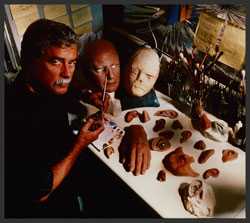The Making of an Artist
Robert Barron is a born artist.
“I was born with the gift to create very realistic art, whether it was a drawing, a disguise, or a prosthetic,” said Barron, a certified clinical anaplastologist and retired CIA disguise specialist.
After completing a degree for commercial art at Southern Illinois University in Carbondale, Barron spent four years in the Marine Corps. When he left the Marine Corps, he was offered a job at the Pentagon in the office of the Chief of Naval Operations as the art director of Directions magazine, the Navy’s public affairs quarterly.
After two years, Barron received a call from someone at the Central Intelligence Agency. He agreed to an interview and was hired to work in the graphic arts department.
Agency Days
During his time at the Agency, Barron participated in three overseas assignments. His responsibility was to work with a team to provide various traditional and advanced disguises for officers in the area.
“The advanced disguises needed to be realistic enough to pass close scrutiny and distract attention away from officers to protect their lives,” Barron said. “Their lives were in jeopardy if the disguise attracted attention.”
Every time he designed a disguise, Barron asked himself one very important question: Would I feel safe wearing this? And if it passed Barron’s close scrutiny, he would then feel comfortable enough to issue the disguise to an officer.
Barron found that he enjoyed his job at the Agency.
“It was challenging, and I like a good challenge,” he said. “Every day at the Agency presented a new challenge. The step-by-step creation of the disguises was a challenge because I knew they had to pass close scrutiny.”
“My work with disguises is what led me to where I am now,” Barron said. “Each piece was unique and demanded creativity, just like the prosthetics I design now.”
Barron is very grateful to all of the people he worked with at the Agency and their contributions to safe, effective disguises.
“I give credit where credit is deserved,” Barron said. “I alone did not perfect the technology.”
From Disguises to Prosthetics
In 1983, Barron attended a conference held by the Association of Biomedical Sculptors. He was there to find out if the commercial world had any new materials to offer for disguise creation. In addition to discovering that the Agency was ahead of the commercial world in research, Barron discovered something life-changing: his second career.
“I saw all these people who had become disfigured by cancer and accidents and what prosthetics did for the quality of their life,” Barron said. “I thought to myself, ‘Bob, if you can change someone’s identity, you could certainly give back a disfigured person’s identity by designing prosthetics.'”
When Barron retired in 1993, he was ready to get started in his new lab. Barron began designing prosthetic ears, eyes, noses, and full-face masks for burn patients. His business started to take off and he was featured in newspapers across the country and on Oprah, The Montel Williams Show, and National Geographic. He even made ears for a burn survivor of the attack on the Pentagon.
Barron found that his prosthetics offered not only medical benefits such as improved hearing and speech, but psychological benefits as well.

After retiring from CIA, Bob Barron leveraged his unique skillset to design custom prosthetics for patients who needed them. Here, Bob works on a prosthesis in his lab. (Photo courtesy of Robert Barron)
“I was helping people return to society and become free from the inquisitive stares and embarrassment they experienced from their differences,” Barron said. “Some of my patients have told me that they used to hide in their homes and were even close to committing suicide before they found me.”
Many of Barron’s patients, especially younger children, have undergone extensive reconstructive surgery to correct their disfigurement. Some have gone through so much surgery that they have lost their faith in medicine.
“Reconstructive surgery does not work,” Barron said. “It always falls short of expectation.”
Barron spoke of one little girl who came in to get a prosthetic ear and was too scared to let Barron take an impression.
“I think she had been through so much with other doctors that she was afraid that I was going to hurt her,” Barron said.
Barron talked to the girl’s father and suggested that he promise her a gift in return for sitting still for the impression. When the little girl returned, she sat still; Barron took the impression without a problem.
“Afterwards, I asked the father what he had promised the little girl. He said a pony,” Barron said.
When Barron reacted, the father replied, “Oh, don’t worry. She’ll forget.”
“A couple weeks later, the father called back and said that they had gotten the little girl a pony,” Barron said with a laugh.
Barron has found great satisfaction in his second career.
“There is nothing better than knowing that I’ve given back someone their identity and quality of life with my work,” Barron said. “I could be working in Hollywood right now, but I wouldn’t get the same satisfaction out of that job. My greatest reward is to see my patients walk out whole again after I’ve given them their prosthesis.”
Many patients tell Barron that they don’t know how to begin to thank him. He just smiles and says, “You already have. Just look at that smile. Your smile is thanks enough.”

